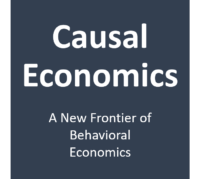What’s the Biggest Difference Between Behavioral Economics and Causal Economics in Marketing?
Behavioral Economics provides a set of powerful and specific types of irrationality that marketers should consider each time they consider customer/prospect engagement. Other articles here lay out many examples. We highly recommend that a BE audit (BEMA) be conducted around each and every communication, to ensure that all relevant insights of BE are leveraged.
We also recommend a Causal Economics Marketing Audit (CEMA) be carried out. A CE audit must capture core BE insights but also show total personal cost and personal total benefit at each stage of the prospect/customer journey. Costs and benefits must go beyond your view, and include everything that impacts the customer, even if that is in areas outside your business. These other things in their life affect their cost and benefit. In addition, personal costs at each stage must be monitored and minimized as much as possible to impede barriers to conversion to the next phase.
A CEMA approach involves visually drawing out the phases a potential buyer goes through and listing (quantifying where possible) the personal costs and benefits they experience at that stage. Next, the marketer flags high cost transitions for attention.
For free CEMA templates email andrewhorton@causaleconomics.com.
